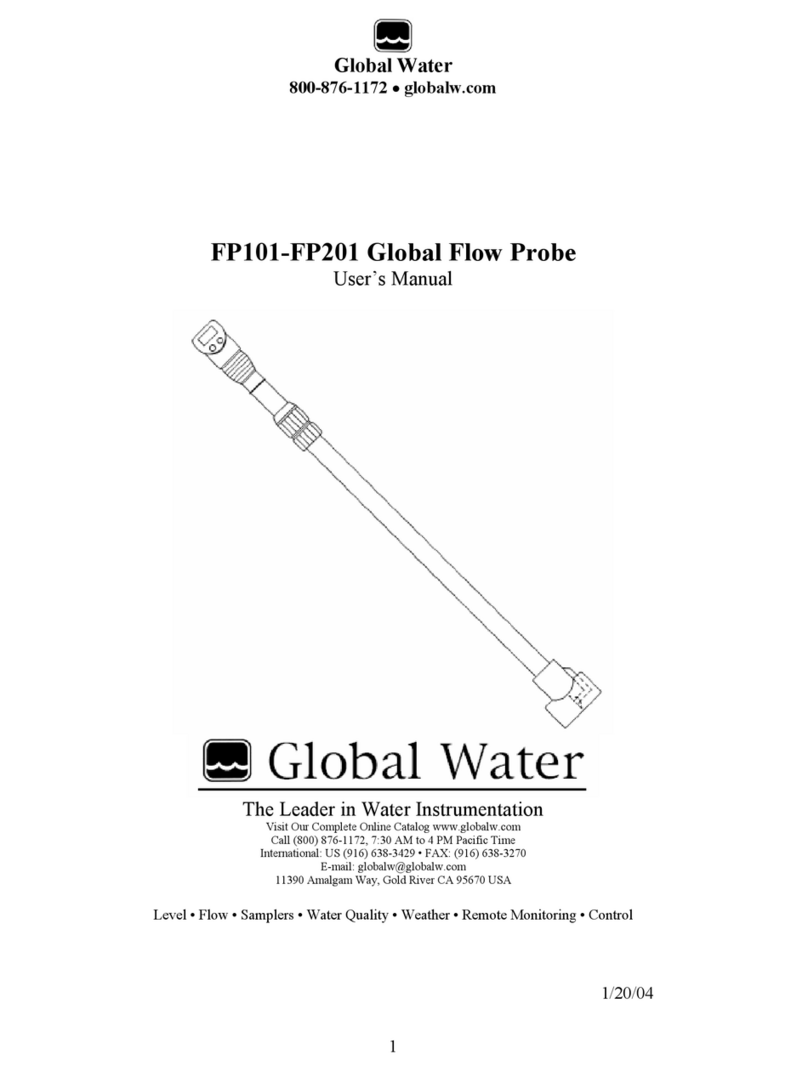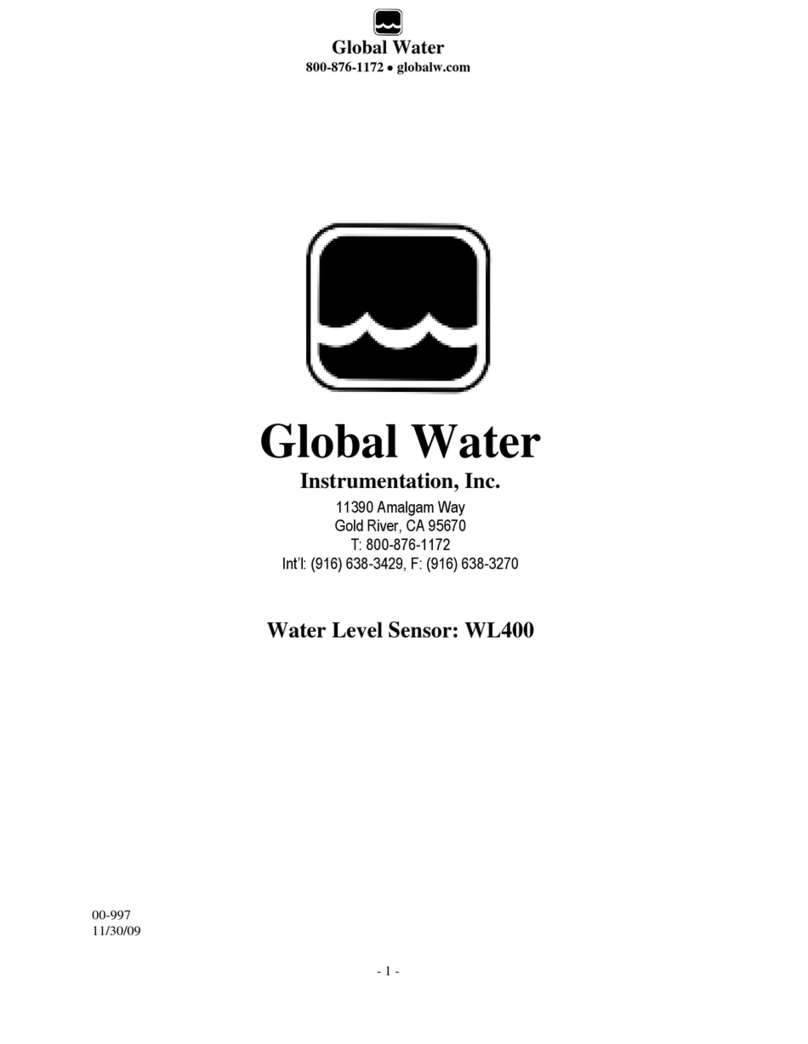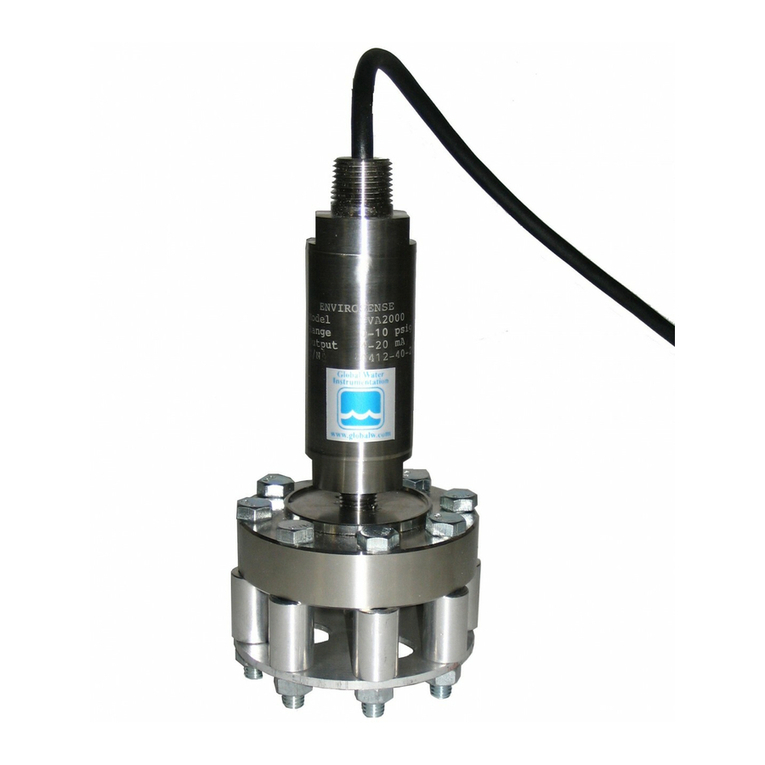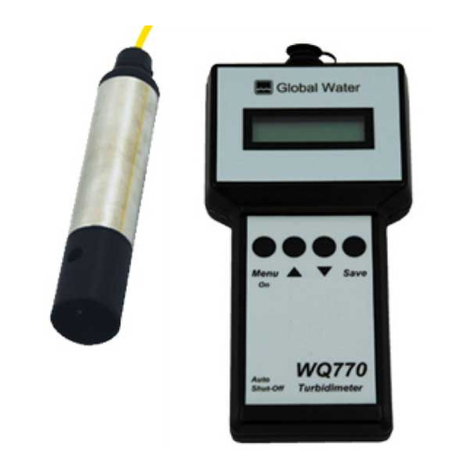globalwater WE100 User manual

Global Water
800-876-1172 •globalw.com
Global Water
Instrumentation, Inc.
11257 Coloma Road
Gold River, CA 95670
T: 800-876-1172
Int’l: (916) 638-3429, F: (916) 638-3270
Barometric Pressure: WE100
Solar Radiation: WE300
Wind Speed: WE550
Wind Direction: WE570
Humidity: WE600
Temperature Sensor: WE700
Solar Shield: WE770
- 1 -

Global Water
800-876-1172 •globalw.com
Congratulations on your purchase of the Global Water Weather Sensor. This
instrument has been quality tested and approved for providing accurate and
reliable measurements. We are confident that you will find the sensor to be a
valuable asset for your application. Should you require assistance, our
technical staff will be happy to help.
Table of Contents
I. Checklist
•••••••Page 3
II. Inspection ••••••3
III. General Sensor Installation ••••4
IV. Barometric Pressure Sensor
••••5
V. Solar Radiation Sensor •••••7
VI. Wind Speed Sensor •••••8
VII. Wind Direction Sensor •••••9
VIII. Humidity Sensor
••••••10
IX. Temperature Sensor •••••11
X. Solar Shield ••••••12
XI. Maintenance ••••••12
XII. Troubleshooting
••••••13
XIII. Warranty
•••••••15
XIV. Appendix A: Temperature Calibration Check ••16
XV. Appendix B: 2 Wire Sensor Measurement Diagram •17
XVI. Appendix C: 3 Wire Sensor Measurement Diagram •18
* Copyright Global Water Instrumentation, Inc. 2002
- 2 -

Global Water
800-876-1172 •globalw.com
I. Sensor Checklist
a. Weather Sensor
b. Weather Sensor Manual
II. Inspection
a. Your Weather sensor was carefully inspected and certified by our
Quality Assurance Team before shipping. If any damage has occurred
during shipping, please notify Global Water Instrumentation, Inc. and
file a claim with the carrier involved.
Use the checklist to ensure that you have received everything needed
to operate the IF200.
- 3 -

Global Water
800-876-1172 •globalw.com
III. General Sensor Installation
a. Weather sensors have many applications and therefore many
installation options. The sensors should be located in a clear area on
a level surface.
b. Install your Weather sensor so that it is easily accessible for calibration
purposes. You may need to remove and reinstall it in the future, so
plan ahead!
c. All Global Water Weather sensors produce a 4-20 mA output signal.
4-20 mA is an industrial standard signal for process control monitoring.
Most PLCs (Programmable Logic Controller), RTUs (Remote
Telemetry Unit), and data acquisition systems accept this signal
directly. If the system only accepts voltage signals, the sensor output
must be converted to a voltage signal by reading the voltage across a
precision resistor in series with the signal wire. Since Ohms Law
states that V = IR, if the 4-20 mA signal is dropped across a 250 ohm
resistor, the output will be 1 to 5 volts DC. If the 4-20 mA signal is
dropped across a 125 ohm resistor, the output will be halved to 0.5 to
2.5 VDC. The 4-20 signal wire is connected to the datalogger voltage
input terminal. The resistor is placed between this input and the
ground terminal of the datalogger’s battery. The power (or voltage to
the sensor) must be connected to positive battery terminal of the
datalogger.
d. The sensors may be pulsed on or turned on by the logging system
prior to taking a reading. Use a warm up time appropriate to the
Weather sensor you are using to assure that the sensor is fully on.
The sensors can run continuously for real time applications. Each
sensor draws between 4 and 20 mA depending on whether the sensor
is reading at the minimum or maximum of its range.
e. Weather sensors may be stored without any special provisions. Place
the sensor inside a bag to keep the sensor clean and store on a shelf
or hang it on a wall.
- 4 -

Global Water
800-876-1172 •globalw.com
IV. Barometric Pressure Sensor
a. Barometric Pressure sensor specifications.
Output: 4-20mA
Range: 800-1100 millibars
Accuracy: +1% of full scale
Operating Voltage: 10-36VDC
Current Draw: Same as sensor output
Warm Up Time: 3 seconds minimum
Operating Temperature: -40° to +55°C
Size of Probe: 3”x2”x1”
Weight: .13 lb.
b. The sensor is a two-wire sensor using the red wire for power and the
black wire for the output signal. Warning: Always connect the
sensor with the power turned off.
c. The barometric pressure sensor may be stored without any special
provisions. Place the sensor inside a bag to keep the sensor clean
and store on a shelf or hang it on a wall.
d. When you read a barometer the reading directly from it is the "station
pressure."
Two things affect the barometer's reading, the high or low air pressure
caused by weather systems, and the air pressure caused by the
station's elevation, or how high it is above sea level. No matter what
weather systems are doing, the air's pressure decreases with height. If
you're trying to draw a weather map of air pressure patterns, you need
a way to remove the effects of the station's elevation. That is, you want
to see what the pressure would be at the station if it were at sea level.
You need to calculate, sea-level pressure, which is defined as: "A
pressure value obtained by the theoretical reduction of barometric
- 5 -

Global Water
800-876-1172 •globalw.com
pressure to sea level. Where the Earth's surface is above sea level, it
is assumed that the atmosphere extends to sea level below the station
and that the properties of that hypothetical atmosphere are related to
conditions observed at the station." To do this, you have to take into
account the barometric reading at the station, the elevation above sea
level, and the temperature.
- 6 -

Global Water
800-876-1172 •globalw.com
V. Solar Radiation Sensor
a. Solar Radiation sensor specifications.
Output: 4-20mA
Range: 0-1500 W m2
Accuracy: 1% of full scale
Operating Voltage: 10-36VDC
Current Draw: Same as sensor output
Warm Up Time: 3 seconds minimum
Operating Temperature: -40°C to +55°C
Size of Probe: 3" diameter x 1 1/2" high
Weight: 1/4 lb.
b. The sensor is a two-wire sensor using the red wire for power and the
black wire for the output signal. Warning: Always connect the
sensor with the power turned off.
c. Ensure that the sensor is placed on a level surface, use the alignment
bolts to adjust the sensor until it is level. Remove the red cap to begin
taking readings.
d. The solar radiation sensor or pyranometer is an instrument for
measuring solar radiation received from a whole hemisphere. It is
suitable for measuring global sun plus sky radiation. Solar radiation
varies significantly among regions. Season and time of day are major
considerations, but surrounding terrain elevation, man-made
obstructions, and surrounding trees can also cause large variations in
locations with a small area. Often, the required measurement is,
energy flux density of both direct beam and diffuse sky radiation
passing through a horizontal plane of known unit area (i.e., global sun
plus sky radiation).
e. Calibration should be confirmed annually.
- 7 -

Global Water
800-876-1172 •globalw.com
VI. Wind Speed Sensor
a. Wind Speed sensor specifications.
Output: 4-20mA
Range: 0-100 MPH
Accuracy: .2 MPH over the range 11 to 55 MPH
Operating Voltage: 10-36VDC
Current Draw: Same as sensor output
Warm Up Time: 3 seconds minimum
Operating Temp: -40° to +55°C
Size of Probe: 7” diameter x 8 ½” long
Weight: 1 lb.
b. The sensor is a two-wire sensor using the red wire for power and the
black wire for the output signal. Warning: Always connect the
sensor with the power turned off.
c. The sensor comes with a stainless steel elbow that can be mounted on
a 1” diameter tube. For best results ensure that the sensor is mounted
parallel to the ground surface.
d. The wind speed sensor or anemometer produces a sine wave voltage
signal with a frequency that changes linearly with the wind speed. The
frequency is transformed into a 4-20 mA sensor signal output.
- 8 -

Global Water
800-876-1172 •globalw.com
VII. Wind Direction Sensor
a. Wind Direction sensor specifications.
Output: 4-20 mA
Range: 0 to 360° (352° electrical, 8° open)
Accuracy: 1% of full scale
Operating Voltage: 10-36VDC
Current Draw: Same as sensor output
Warm Up Time: 3 seconds minimum
Operating Temp: -40° to +55°C
Size: 8 ½” diameter x 10 ½” long
Weight: 1 lb.
b. The sensor is a two-wire sensor using the red wire for power and the
black wire for the output signal. Warning: Always connect the
sensor with the power turned off.
c. The ridge on the fixed portion of the sensor represents the 0° direction
of the sensor. The sensor comes with a stainless steel elbow that can
be mounted on a 1” diameter tube. For best results ensure that the
sensor is mounted parallel to the ground surface.
d. A wind direction sensor produces a ratiometric voltage signal. That
voltage signal is transformed into a 4-20 mA sensor output signal.
- 9 -

Global Water
800-876-1172 •globalw.com
VIII. Humidity Sensor
a. Humidity sensor specifications.
Output: 4-20mA
Range: 0-100% RH
Accuracy: + 2% RH
Operating Voltage: 10-36VDC
Current Draw: 3 mA plus sensor
Warm Up Time: 3 seconds minimum
Operating Temp: -40° to +55°C
Size of Probe: 1 ½” diameter x 7” long
Weight: ½ lb.
b. The humidity sensor is a three-wire sensor. Three wire sensors use
the red wire for positive voltage, the white wire for the output signal,
and the black wire for ground. Warning: Always connect the
sensor with the power turned off.
c. Do not install the humidity sensor in direct sunlight.
d. A humidity sensor utilizes a thin polymer that varies in dielectric
constant directly proportional to changes in the amount of water vapor
at the sensor element. The element provides a linear voltage output
that is converted into a 4-20 mA sensor output signal.
- 10 -

Global Water
800-876-1172 •globalw.com
IX. Temperature Sensor
a. Temperature sensor specifications.
Output: 4-20mA
Range: -50° C to + 50° C
Accuracy: ±0.2° F or ±0.1° C
Operating Voltage: 10-36VDC
Current Draw: Same as sensor output
Warm Up Time: 5 seconds minimum
Operating Temperature: -50°C to +100°C
Size of Probe: ¾" diameter x 4 ½" long
Weight: ½ lb.
b. The sensor is a two-wire sensor using the red wire for power and the
black wire for the output signal. Warning: Always connect the
sensor with the power turned off.
c. Do not install the temperature sensor in direct sunlight.
d. To check the temperature sensor calibration you will need:
1 thermometer
3 containers of water
1 power supply
1 current meter
Connecting wires as necessary
Connect the sensor to the power supply and current meter in
the following way. Attach the black wire to the positive input of the
current meter. Connect the ground terminal of the power supply to the
ground of the current meter. Attach the red wire to the positive
terminal of the power supply. Warning: Always connect the sensor
with the power turned off.
See Appendix A for the temperature calibration worksheet.
- 11 -

Global Water
800-876-1172 •globalw.com
X. Solar Shield
a. Solar Shield specifications.
Size: 4” diameter x 8 ½” long
Weight: 1 lb.
b. The solar shield is used to protect sensors, typically humidity and
temperature, from direct sunlight. Insert a sensor into one of the two
holes located on the underside of the shield. The shield provides a
friction lock so the sensors will not accidentally fall out. The sensors
can be removed by firmly twisting and pulling them out of the solar
shield.
c. The shield comes with a stainless steel elbow that can be mounted on
a 1” diameter tube. For best results ensure that the shield is mounted
vertically.
XI. Maintenance
a. Global Water recommends confirming the calibration annually.
b. The sensors should be cleaned periodically. Sensors can be cleaned
using a damp cotton cloth. NOTE: DO NOT submerge sensors. The
sensors are water resistant, not water proof.
- 12 -

Global Water
800-876-1172 •globalw.com
XII. Trouble Shooting
Issue: Sensor reading incorrectly
a. Verify power source is supplying correct voltage.
b. Clean the sensor.
c. Confirm the sensor’s calibration.
Other issues
d. Call Global Water for tech support: 800-876-1172 or 916-638-3429
(many problems can be solved over the phone). Fax: 916-638-3270 or
Email: [email protected].
When calling for tech support, please have the following information
ready;
1. Model #.
2. Unit serial number.
3. P.O.# the equipment was purchased on.
4. Our sales number or the invoice number.
5. Repair instructions and/or specific problems relating to the
product.
Be prepared to describe the problem you are experiencing including
specific details of the application, installation, and any additional
pertinent information.
e. In the event that the equipment needs to be returned to the factory for
any reason, please call to obtain an RMA# (Return Material
Authorization). Do not return items without an RMA# displayed on the
outside of the package.
Clean and decontaminate the sensor if necessary.
Include a written statement describing the problems.
- 13 -

Global Water
800-876-1172 •globalw.com
Send the package with shipping prepaid to our factory address. Insure
your shipment, Global Water’s warranty does not cover damage
incurred during transit.
- 14 -

Global Water
800-876-1172 •globalw.com
XIII. Warranty
a. Global Water Instrumentation, Inc. warrants that its products are free
from defects in material and workmanship under normal use and
service for a period of one year from date of shipment from factory.
Global Water’s obligations under this warranty are limited to, at Global
Water’s option: (I) replacing or (II) repairing; any products determined
to be defective. In no case shall Global Water’s liability exceed the
products original purchase price. This warranty does not apply to any
equipment that has been repaired or altered, except by Global Water
Instrumentation, Inc., or which has been subject to misuse, negligence
or accident. It is expressly agreed that this warranty will be in lieu of
all warranties of fitness and in lieu of the warranty of merchantability.
b. The warranty begins on the date of your invoice.
- 15 -

Global Water
800-876-1172 •globalw.com
XIV. Appendix A: Temperature Calibration check
Step 1) Fill a container of water with enough ice that it will not melt
quickly.
Step 2) Place the temperature sensor and thermometer into the
container. Turn on the power supply and the current meter.
Let the sensor stabilize for 30 minutes before taking any
measurements.
Step 3) Record the ice bath temperature, IT= _______, and record the
output current of the sensor, IC= _______.
Step 4) Fill a container with enough warm water that it will not cool
down quickly.
Step 5) Place the temperature sensor and thermometer into the
container. Turn on the power supply and the current meter.
Let the sensor stabilize for 30 minutes before taking any
measurements.
Step 6) Record the warm water temperature, WT= _______, and
record the output current of the sensor, WC= _______.
Step 7) Subtract IC from WC, WC- IC = _______ = C.
Step 8) Subtract IT from WT, WT- IT = _______ = T.
Step 9) Calculate B. WC– (C/T)(WT)= _______ = B.
Step 10) Find the low current value for the sensor. –(C/T)(50)+B= _____
= LC. This current is the output current the sensor would
produce if the temperature were -50°C.
Step 11) Find the high current value for the sensor. (C/T)(50)+B= _____
= HC. This current is the output current the sensor would
produce if the temperature were 50°C.
Step 12) Use these new current values to recalibrate the system that is
monitoring the sensor output.
- 16 -

Global Water
800-876-1172 •globalw.com
XV. Appendix B: 2 Wire Sensor Measurement Diagram
- 17 -

Global Water
800-876-1172 •globalw.com
- 18 -
XVI. Appendix C: 3 Wire Sensor Measurement Diagram
This manual suits for next models
6
Table of contents
Other globalwater Accessories manuals





















